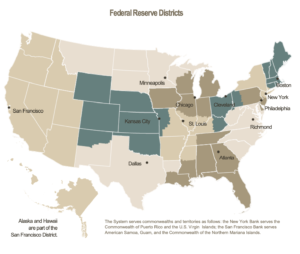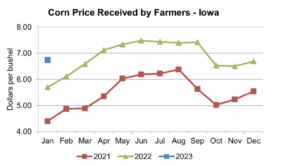Agriculture Secretary Brooke Rollins said on Tuesday that the Trump administration will announce a 'bridge payment' for farmers next week that is designed to provide short-term relief while longer trade…
Federal Reserve: Observations on the Ag Economy- February 2023
On Wednesday, the Federal Reserve Board released its February 2023 Beige Book update, a summary of commentary on current economic conditions by Federal Reserve District. The report included several observations pertaining to the U.S. agricultural economy.

* Sixth District- Atlanta– “Agricultural conditions remained mixed. Demand for beef increased, especially for calves, following the downsizing of Texas herds during the recent drought. Demand for milk declined amid reduced exports of powdered milk to China, and demand for butter fell from high levels. Cotton demand remained weak. While Florida’s production of citrus fruits was limited by tree damage, demand remained strong.
The Avian flu continued to limit the supply of eggs, which are generally sold domestically, and to drive prices upward.
“However, Avian flu-related restrictions on exports substantially softened global demand for poultry meat, thus increasing domestic supply; poultry companies reported losing money amid high costs and falling prices.”
* Seventh District- Chicago– “Contacts’ forecasts for District agricultural income for 2023 were mostly for near average returns, down from an above average 2022. Wheat prices were up, in part because of longer Russian inspection times for Ukrainian grain shipments and buyers’ greater reluctance to enter purchase agreements given uncertainty about whether the shipping deal with Russia would continue. Corn and soybean prices were also higher, spurred by uncertainty about the size of South American harvests.

“Contacts noted that lower costs for some inputs would help farm incomes but rising feed costs were a continuing concern for livestock producers. Egg prices dropped from extremely high levels, and dairy prices were generally lower.
There were reports of closures of smaller dairy operations, for which higher interest rates on loans were making it more expensive to expand to a more profitable scale.
“Cattle and hog prices moved higher during the reporting period.”
* Eighth District- St. Louis– “District agriculture conditions have declined moderately since our previous report. The number of acres of winter wheat planted in the District this season has increased by 27% compared with this period a year ago. These increases range from 15-55% across District states with the lone exception of Arkansas, which saw a moderate decrease of 14%. District contacts are no longer optimistic on the outlook for the rest of the year, due to concern about the increased cost of inputs, especially labor. Additionally, contacts noted sales were either at or below expectations, and some contacts expressed concern that higher interest rates were putting additional strain on their balance sheets.”
* Ninth District- Minneapolis– “District agricultural conditions remained strong heading into the end of winter. According to the Minneapolis Fed’s fourth quarter (January) agricultural credit conditions survey, nearly three-quarters of lenders reported farm incomes increased from October through December compared with the same period a year earlier. Farm household spending, capital spending, and loan repayment rates also increased on balance, while demand for loans fell.”
* Tenth District- Kansas City– “The farm economy in the Tenth District remained strong, but risks to the outlook lingered. In the livestock sector, cattle prices increased slightly in February and reached multi-year highs alongside lower inventories. In the crop sector, prices of corn, soybeans and wheat remained high and continued to support profitability.
Despite strong market conditions, District contacts reported that elevated production costs, higher interest rates, and ongoing drought in some areas have put downward pressures on profit margins for many producers.
“Cost pressures have been particularly challenging for livestock operations, with several reports of early calf sales and herd liquidation as a result of intense drought and high feed costs, which could reduce revenues going forward.”
Approximately 47% of the #cattle inventory is within an area experiencing #drought. pic.twitter.com/dsBB5tLAFB
— FarmPolicy (@FarmPolicy) March 9, 2023
* Eleventh District- Dallas– “Agricultural conditions improved slightly over the reporting period. Though much of the district remained in some level of drought, the winter wheat crop was faring better this year than last. Spring row crop planting was on the horizon, and contacts expect an increase in grain acres and a decrease in cotton acreage in 2023. Agricultural commodity prices were relatively high, and some improvement was seen in input costs, particularly fertilizer. Cattle prices rose amid solid beef demand, while egg prices have declined after surging at the beginning of the year.”
* Twelfth District- San Francisco– “Conditions in agriculture and resource-related sectors softened slightly. While international transportation bottlenecks eased further, demand from abroad continued to be hampered by the strong dollar. One contact observed that producers continued to shift sales to domestic markets, and another commented that domestic demand has been high enough to largely absorb available supply. However, demand for produce from retailers and food services providers was reportedly either stable or down in recent weeks. Contacts continued to report low crop yields due to drought conditions, while a contact in Alaska noted continued stability in some major seafood stocks. Input costs, such as labor, energy, water, and fertilizer, increased, though one contact in the Pacific Northwest noted that food transportation costs fell substantially.”





